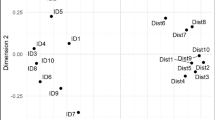Abstract
This study examined the antecedents of awareness in geographically distributed teams. Task structure, group propensity, communication frequency, groupware usage, and subjective reliance on various communication tools were proposed to affect the perceived level of awareness. Based on data collected from seven distributed student engineering teams, results showed that perceived task interdependence and communication frequency were positively associated with the level of awareness, but group propensity and groupware usage were not. Further analysis found the reliance on synchronous meetings mediated the relationship between task interdependence and awareness level. Implications for virtual team management are discussed.
Preview
Unable to display preview. Download preview PDF.
Similar content being viewed by others
References
Cramton, C.: Information problems in dispersed teams. In: Academy of Management Best Paper Proceedings, Southern University, Georgia, pp. 298–302 (1997)
Steinfield, C., Jang, C.-Y., Pfaff, B.: Supporting virtual team collaboration: the TeamSCOPE system. In: Group 1999. ACM Press, Phoenix (1999)
Tang, J.C.: Approaching and leave-taking: Negotiating contact in computer-mediated communication. ACM Transactions on Computer-Human Interaction 14(1) (2007)
Gutwin, C., Greenberg, S.: The Importance of awareness for team cognition in distributed collaboration. In: Salas, E., Fiore, S. (eds.) Team Cognition: Understanding the Factors that Drive Process and Performance, pp. 177–201. APA Press, Washington (2004)
Jang, C.-Y., Steinfield, C., Pfaff, B.: Virtual team awareness and groupware support: an evaluation of the TeamSCOPE system. International Journal of Human-Computer Interaction 56(1), 109–126 (2002)
Dourish, P., Bellotti, V.: Awareness and coordination in shared workspace. In: CSCW 1992. ACM Press, Toronto (1992)
Gutwin, C., Roseman, M., Greenberg, S.: A usability study of awareness widgets in a shared workspace groupware system. In: CSCW 1996. ACM Press, Cambridge (1996)
Cadiz, J.J., et al.: All ways aware: Designing and deploying an information awareness interface. In: The 2002 ACM conference on Computer supported cooperative work CSCW 2002, New Orleans, Louisiana, USA (2002)
Ganoe, C.H., et al.: Classroom BRIDGE: using collaborative public and desktop timelines to support activity awareness. In: The 16th annual ACM symposium on User interface software and technology, Vancouver, Canada (2003)
Biehl, J.T., et al.: Distributed coordination: FASTDash: a visual dashboard for fostering awareness in software teams. In: CHI 2007, San Jose, California, USA (2007)
Schmidt, K.: The problem with ‘awareness’. Computer Supported Cooperative Work 11, 285–298 (2002)
Harper, R.H.R., Hughes, J.A., Shapiro, D.Z.: Working in harmony: An examination of computer technology in air traffic control. In: ECSCW 1989: the First European Conference on Computer Supported Cooperative Work. Gatwick, London (1989)
Heath, C.C., Luff, P.: Collaborative activity and technological design: Task coordination in London Underground control rooms. In: ECSCW 1991: the Second European Conference on Computer-Supported Cooperative Work. Kluwer Academic Publishers, Amsterdam (1991)
Thompson, J.D.: Organizations in Action. McGraw-Hill, New York (1967)
Van de Ven, A.H., Delbecq, A.L., Koenig, R.J.: Determinants of coordination modes within organizations. American Sociological Review 41(3), 322–338 (1976)
Campion, M.A., Medsker, G.A., Higgs, C.A.: Relations between work group characteristics and effectiveness: Implications for designing effective work groups. Personnel Psychology 46, 823–850 (1993)
Maznevski, M.L., Chudoba, K.M.: Bridging space over time: virtual team dynamics and effectiveness. Organization Science 11(5), 473–492 (2000)
Staples, D.S., Jarvenpaa, S.L.: Using electronic media for information sharing activities: a replication and extension. In: The Twenty-First International Conference on Information Systems, Brisbane, Queensland, Australia (2000)
Shaw, J.D., Duffy, M.K.: Interdependence and preference for group work: Main and congruence effects on the satisfaction and performance of group members. Journal of Management 26(2), 259–279 (2000)
Wageman, R.: Interdependence and group effectiveness. Administrative Science Quarterly 40, 145–180 (1995)
Van der Vegt, G., Emans, B., Van de Vliert, E.: Effects of interdependencies in project teams. The Journal of Social Psychology 139(2), 202–214 (1999)
Baron, R.M., Kenny, D.A.: The moderator-mediator variable distinction in social psychological research: Conceptual, strategic, and statistical considerations. Journal of Personality and Social Psychology 51(6), 1173–1182 (1986)
Ferreira, A., Antunes, P., Pino, J.A.: Evaluating shared workspace performance using human information processing models. Information Research 14(1) (2009)
Daft, R.L., Lengel, R.H.: Information richness: A new approach to managerial behavior and organization design. Research in Organizational Behavior 6, 191–233 (1984)
Author information
Authors and Affiliations
Editor information
Editors and Affiliations
Rights and permissions
Copyright information
© 2009 Springer-Verlag Berlin Heidelberg
About this paper
Cite this paper
Jang, CY. (2009). Antecedents of Awareness in Virtual Teams. In: Carriço, L., Baloian, N., Fonseca, B. (eds) Groupware: Design, Implementation, and Use. CRIWG 2009. Lecture Notes in Computer Science, vol 5784. Springer, Berlin, Heidelberg. https://doi.org/10.1007/978-3-642-04216-4_11
Download citation
DOI: https://doi.org/10.1007/978-3-642-04216-4_11
Publisher Name: Springer, Berlin, Heidelberg
Print ISBN: 978-3-642-04215-7
Online ISBN: 978-3-642-04216-4
eBook Packages: Computer ScienceComputer Science (R0)




